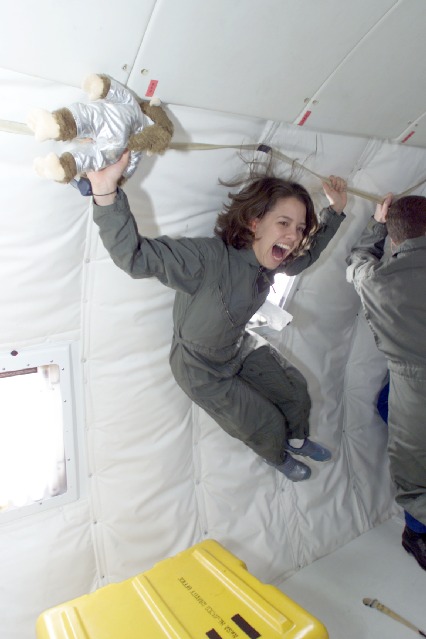A misconception arises when we ask people about the role that gravity plays in space.
If you watch movies set in space — or for that matter, read statements from NASA —you will be led to think that gravity is absent in space. After all, people often refer to space as a “zero gravity” environment (the movie 2001: A Space Odyssey famously showed a complex set of instructions for its “zero gravity toilet”), and NASA usually refers to the conditions in orbit as “microgravity.”
My new book, What Is Relativity? An Introduction to Einstein’s Theories, And Why They Matter, tackles this and other science issues in a common sense way. To see why these descriptions are so misleading, consider this experiment that I’ve done with thousands of high school and college students.
First, ask “Why are astronauts weightless in space?” Almost all the students will answer “because there’s no gravity in space.” Then immediately follow with “Why does the Moon orbit the Earth?” The students will begin to say “because of gravi…” — at which point you’ll literally see jaws drop as they realize that they are about to give you an answer that directly contradicts the one they gave you a few seconds before.
In other words, most people know that gravity keeps Earth orbiting the Sun and the Moon orbiting Earth, which clearly means that there is gravity in space. In fact, simple calculations show that the strength of Earth’s gravity in low-Earth orbit is only about 10% less than the strength of gravity right here on the ground, and it is this relatively strong gravity that holds spacecraft and astronauts in orbit rather than allowing them to fly off into deep space.
So why, then, do the astronauts float around as if there's no gravity? To understand the answer, first imagine that you are standing on a scale on the edge of a diving platform. The scale reads your weight because gravity is pushing you against it, while the platform makes sure the scale stays in place.Now suppose that someone pushes you and the scale off the platform, so you both start falling toward the water. Because you and the scale are both falling —you are in free fall — you’ll no longer be pushing against the scale and it will therefore read zero. In other words, while you are falling, you will have become weightless.

More generally,you are in free fall and therefore weightless whenever there is no ground or anything else pushing back against you. That’s why gymnasts and divers can tumble and twist like astronauts while they are in the air. The only difference is that astronauts remain weightless for much longer, which brings us to the true role of gravity.
Gravity is always present in space and always pulling everything in Earth orbit toward the ground, including the Shuttle, the Hubble Space Telescope, the International Space Station, and the astronauts. The only reason these objects don’t quickly crash to Earth is that they are also moving forward at the same time, and at a very high speed — about 17,000 miles per hour at the Space Station’s altitude.
This speed essentially ensures that they move forward just as rapidly as they fall, and as a result they remain at the same altitude as they circle around Earth. (It reminds me of Douglas Adams’ statement in The Hitchhiker’s Guide to the Galaxy that the trick to flying is to “throw yourself at the ground and miss.”) And this is what happens if a bit of air resistance begins to slow you down: You then start to lose altitude, which causes a fiery reentry as you plow through the atmosphere at high speed.
To summarize the lessons: There is gravity in space, and in low-Earth orbit its strength is only a little different than its strength on the ground. Therefore, “zero gravity” and“microgravity” are both misnomers, and the correct explanation for what really happens in space — is that astronauts are weightless because they are in a continual state of free fall as they orbit Earth.
Given that there’s nothing actually “micro” about gravity in space, you may wonder why NASA talks about “microgravity.” Personally, I think it is a very poor word choice, but here’s the rationale behind it: In flight training, it’s standard to describe the forces that pilots (or astronauts) feel when they accelerate in “gees,” a term that comes from the physics abbreviation g for the acceleration of gravity. For example, a force of one gee means you feel your normal weight, two gees means you feel twice your normal weight, and so on. When you are in freefall and hence weightless, you don’t feel any force on you at all, which means we can say the force on you is “zero gees.”
In other words, we can say that you feel a force of zero gees in orbit, even though there’s still plenty of gravity. In their drive for precision, NASA recognized that the forces on orbiting spacecraft and astronauts are not exactly zero, because they are always subject to at least some tiny accelerations from forces that include Earth’s tidal influence; NASA therefore decided that it would be more accurate to say “micro gees” rather than “zero gees,” which they then translated into the term “microgravity.”
So the term arose with good intentions, but it’s still misleading and therefore far better to describe the conditions of free fall and orbit as weightlessness (or near-weightlessness if you want to be as precise as NASA).
*****
Jeffrey Bennett, Ph.D., astrophysicist and author of What Is Relativity? An Introduction to Einstein’s Theories, And Why They Matter (Columbia University Press, 2014).
Bennett is also the author of five children’s books that are currently in orbit onboard the International Space Station, where they are being read by astronauts as a part of Story Time From Space. Learn more at www.jeffreybennett.com and follow Jeff on Twitter @JeffreyOBennett.






Comments